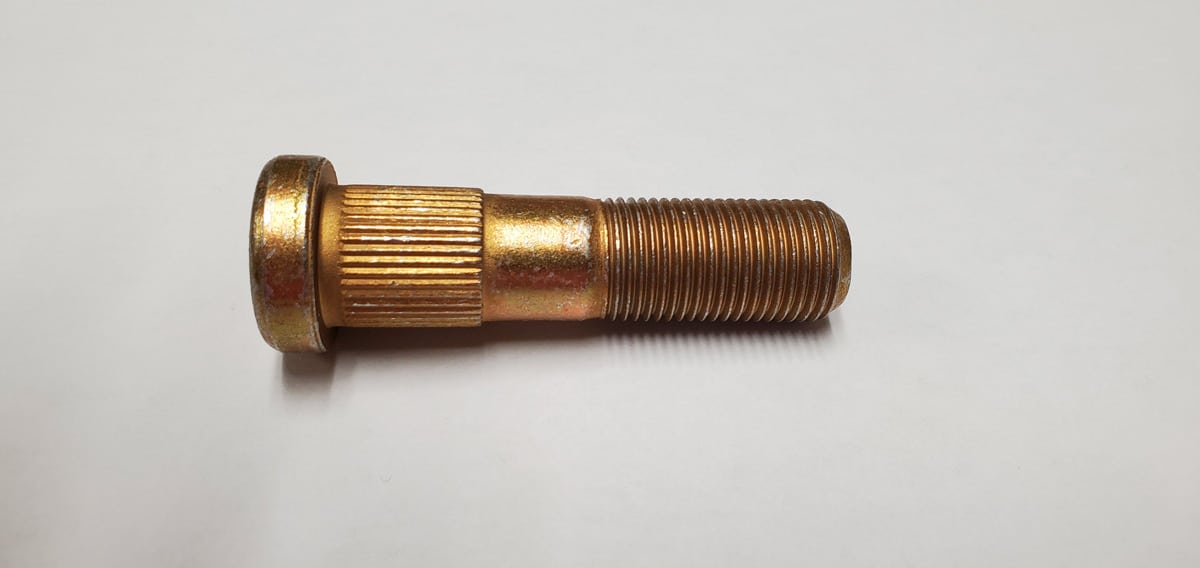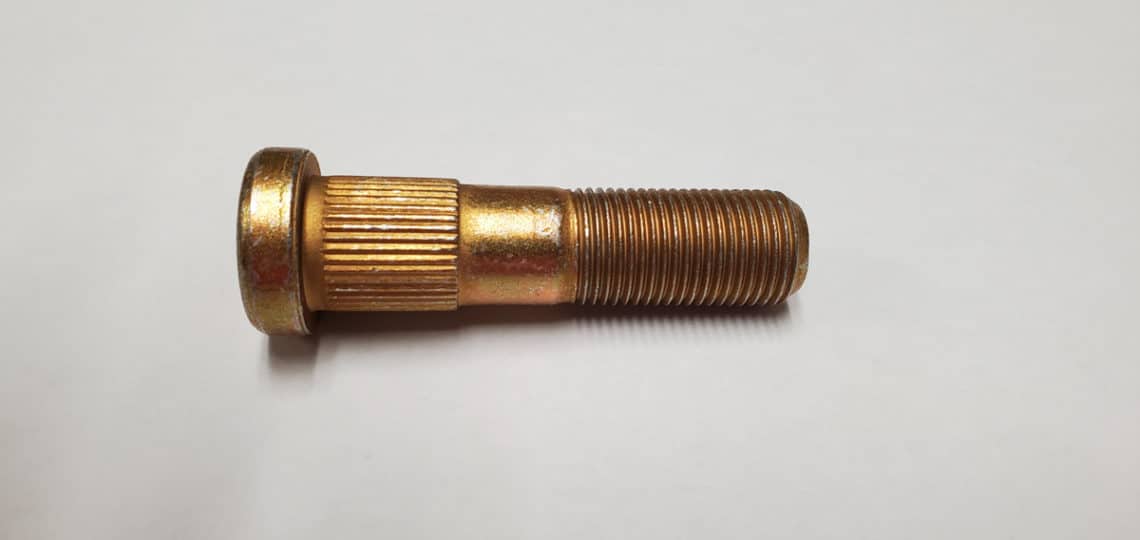Surface finishes are often applied to plain steel fasteners in order to improve performance. When it comes to steel bolts and screws, there are dozens of different coatings and platings to choose from, each with different properties and costs.
For the purposes of this article, we’ll present a basic introduction to five types of finishes that our customers specify to us far more than any others. All of these finishes are good options and do the job they were designed to perform. The following list is ordered from our highest to lowest volume:
- Zinc Phosphate & Oil Coating (Phos & Oil)
- Zinc Electroplate (Zinc)
- Cadmium Electroplate (Cad)
- Zinc Non-Electrolytically Applied Coating (Zinc Flake)
- Zinc-Nickel Plating (Zn-Ni)
Importance of Surface Finishes for Steel Bolts and Screws
Surface finishes are applied to steel bolts and screws for a number of reasons, but the primary one is to improve corrosion resistance. Corrosion resistance is a material’s ability to withstand damage caused by oxidation or other chemical reactions.
Each finish offers a different level of corrosion resistance. Typically, the higher the corrosion resistance of a finish, the more it costs.
Key Considerations: Cost & Corrosion Resistance
The bolt and screw finishes discussed in this article all have different costs and corrosion resistance. As always, cost is influenced by volume. Therefore, the costs provided in this article are relative and can vary. They are our best estimates based on our experience over the last year.
Corrosion resistance is measured using a standard neutral salt spray test (NSS), which is specified in certain quality standards like ASTM B117 or ISO 9227. Parts are exposed to a salt spray inside of a test chamber for a specified test time in hours. The parts are then visually examined for the appearance of corrosion. If parts are free from corrosion after the specified test time, the parts are said to have passed the test. Higher hours specify higher corrosion resistance.
For our five finishes, we have presented the relative costs along with the specified minimum hours of corrosion resistance in Table 1.
| Comparison of Common Surface Coatings | ||
| Coating | Relative Cost | Corrosion Resistance
(NSS Hours) |
| Phos & Oil | 1 | 2-72 |
| Zinc | 2 | 72-384 |
| Zi-Ni | 6 | 1000 |
| Cad | 9 | 72-168 |
| Zinc Flake | 12 | 240-1000 |
Table 1 – Comparison of Common Surface Coatings
RELATED: Need a specialty bolt, screw, or stud? Wilson-Garner can help.
5 Steel Bolt and Screw Surface Finishes
Let’s take a look at the properties and benefits of each of these five finishes. There are multiple standards and OEM specifications for each type of finish. We will reference the ones that our customers most often require.
Zinc Phosphate & Oil Coating (Phos & Oil)
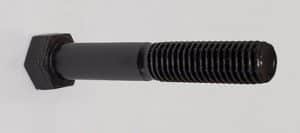
Zinc phosphate and oil is a liquid bath chemical conversion process followed by the application of protective oil. The coating is thin and black. This is the lowest cost finish option of the finishes we are examining.
This coating provides corrosion protection suitable for handling, packing, storing, and general use in everyday dry ambient conditions. 82% of the specifications we receive from customers are one of the following specs (see Table 2).
| Common Phos & Oil Specifications | ||
| Specification | Color | Corrosion Resistance
(NSS Hours) |
| GMW3179 – Oil | Black | 24 |
| GMW3179 – Oil with Corrosion Preventative | Black | 72 |
| MIL-DTL-16232 – Oil | Black | 2 |
| MIL-DTL-16232 – Oil with Corrosion Preventative | Black | 72 |
Table 2 – Common Phos & Oil Specifications
Phosphate and oil coatings slightly increase the lubricity compared to plain steel parts. In general, there is no coefficient of friction (COF) requirement. GMW3179 does have a topcoat with friction control option with a COF of 0.13 ±0.03.
Screws and bolts finished with phos & oil have a very low risk for hydrogen embrittlement. Hardened parts must be processed per the above specifications to detect and eliminate hydrogen. In over 40 years, our company has never seen any hydrogen embrittlement in our phos & oil coated products.
Hydrogen embrittlement can be more of an issue with other types of finishes, as we’ll see below.
Zinc Electroplate (Zinc)
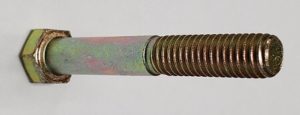
Zinc electroplate is the cathodic deposition of metallic zinc onto the steel fastener surface from an ionic water solution driven by the application of electrical current. The basic finish is gray in color. However, the color can be changed by the application of chromate coatings or passivation methods, so many colors are available.
Zinc electroplate is versatile. You can apply a range of zinc thicknesses on parts that increase the corrosion resistance. Thinner coatings are suitable for dry indoor conditions, thicker layers for wet outdoor and saline exposure.
As you can see in Table 1, zinc costs twice as much as phos & oil, but it provides more corrosion protection. 62% of the zinc specifications we get from customers, the most by a wide margin, are ASTM B633-19. The exact call out is ASTM B633 type II SC2 with yellow dichromate, shown in the picture above. SC2 is the moderate thickness class 8 µm (0.0003″).
Let’s compare this specification to others with the same thickness for corrosion resistance (see Table 3).
| Common Zinc Electroplate Specifications | ||
| Specification | Color | Corrosion Resistance
(NSS Hours) |
| ASTM B633-19 Type II SC2 | Yellow | 96 |
| ASTM F1941-17 FE/ZN 8C | Yellow | 120 |
| GMW3044 9U72/0 | Clear | 72 |
| GMW3044 8K240/120 | Clear | 240 |
| Ford 347U Passivate | Clear | 200 |
Table 3 – Common Zinc Electroplate Specifications
Zinc electroplate has a moderately rough surface, which decreases the lubricity compared to plain steel bolts and screws. Historically, zinc specifications have not had requirements for lubricity. The companies that make chemicals for zinc electroplate have developed sealers and lubricants that improve lubricity and corrosion resistance.
A good example is the OEM specification for the Ford S437 zinc finish. The NSS requirement is 384 hours and the COF is 0.15.
One potential downside to electroplated zinc is hydrogen embrittlement. Hydrogen is produced at the surface of steel during the electroplating process. Hydrogen can penetrate into the steel and cause embrittlement in hardened high-strength parts. Plating specifications account for this possibility by including post-electroplating baking procedures that decrease the amount of hydrogen in the steel. These baking requirements can be as long as 24 hours or more, depending on the plating thickness.
For more information on baking requirements, we recommend checking out ASTM B850 Table 1.
Cadmium Electroplate (Cad)
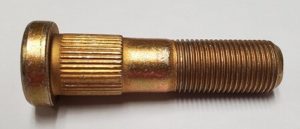
Cadmium electroplate is produced using the same process as zinc. The basic finish is gray. The color can be changed by the application of chromate coatings.
Cad used to be specified extensively on commercial and military fasteners. However, in recent years, cad has been virtually eliminated from commercial products because of its toxicity. It‘s also been eliminated from new design for military parts. The only cad specification we continue to get from customers is AMS QQ-P-416.
The exact call out is AMS-QQ-P-416 Type II CL2 (0.0003) with yellow dichromate, shown to the left. Let’s look at the corrosion resistance for (0.0003″) thickness parts (see Table 4).
| Common Cadmium Electroplate Specifications | ||
| Specification | Color | Corrosion Resistance
(NSS Hours) |
| AMS QQ-P-416 Type II CL2 | Yellow | 96 |
| ASTM F1941-17 FE/CD 8C | Yellow | 72 |
Table 4 – Common Cadmium Electroplate Specifications
Cad electroplate has a smooth surface that increases the lubricity compared to plain steel bolts and screws. There is no COF requirement in the two referenced specifications. Cad parts coated to AMS QQ-P-416 torque more consistently than zinc parts coated per the above ASTM B633.
High-strength, hardened cad-electroplated parts must also be baked after plating to reduce the risk of hydrogen embrittlement.
Cad pricing used to be competitive with that of zinc electroplating. However, the relative rarity of cad usage has caused many plating applicators to stop offering cad plating. As a result, the price of cad has increased to more than four times that of zinc.
Zinc Non-Electrolytically Applied Coating (Zinc Flake)
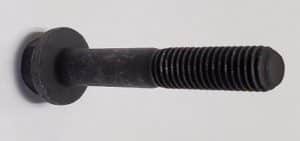
Zinc flake is a coating that is non-electrolytically applied to the surface of a bolt or screw. Parts are dipped into a zinc-rich liquid, removed, spun to remove excess coating, and cured using heat.
This process produces a zinc flake base coat that is gray in color. Various topcoats can be added that contain lubricants or pigments for color (typically black), if desired. A good general reference for zinc flake coating is ISO 10683:2018.
As you can see below in Table 5, zinc flake coatings provide very good corrosion resistance. This high level of corrosion resistance is necessary for parts designed to be used in harsh environments.
| Common Zinc Flake Specifications | ||
| Specification | Color | Corrosion Resistance
(NSS Hours) |
| TACOM 12424710 Method 4 | Black | 700 |
| GMW3359 Code A | Grey | 720 |
Table 5 – Common Zinc Flake Specifications
For our company, the cost of zinc flake is on the high end — twelve times as much as the cost for phos & oil. However, it must be noted that our volume for zinc flake is much lower than our volume for phos & oil, and this low volume will result in a higher price. Over 90% of the zinc flake specifications we get from customers are US Army/TACOM 12424710 Method 4 black (left, top) and GMW3359 Code A gray (left, bottom). Both specifications have a thickness class of 12 µm (0.0005″).
Lubricants are commonly applied to zinc flake to increase lubricity. TACOM 12424710 has a COF requirement of 0.13 ±0.03 using the ISO 16047 test method. GMW3359 requires a COF determination per ISO 16047 in the part approval process.
Since it’s not applied using the electroplating method, zinc flake coated fasteners have no risk for hydrogen embrittlement, which is always a good thing.
Zinc-Nickel Electroplate (Zn-Ni)
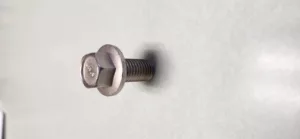 Historically, zinc-nickel electroplate has not been as common as the other finishes listed here. However, it’s recently gained popularity as a less toxic, more environmentally friendly alternative to cadmium. New government regulations are pushing for use of zinc-nickel, encouraging more automotive, truck, military vehicle, and engine designers to fully replace cadmium with it.
Historically, zinc-nickel electroplate has not been as common as the other finishes listed here. However, it’s recently gained popularity as a less toxic, more environmentally friendly alternative to cadmium. New government regulations are pushing for use of zinc-nickel, encouraging more automotive, truck, military vehicle, and engine designers to fully replace cadmium with it.
Zinc-nickel typically consists of a 8-14 μm layer of 12-16% nickel alloy next to the steel material, topped with a 0.06-0.15 μm trivalent passivate layer and a 0.5-4 μm layer of top coat. It offers great corrosion resistance (up to 10x higher than conventional zinc), wear resistance in moving parts, and thermal stress resistance in parts subject to high operating temperatures.
Because it’s applied using the electroplating method, zinc-nickel coated fasteners are at risk for hydrogen embrittlement. They must be baked after plating to reduce the risk.
Here’s a look at common zinc-nickel specifications and their corrosion resistance levels (see Table 6).
| Common Zinc-Nickel Specifications | ||
| Specification | Color | Corrosion Resistance NSS Hours |
| MIL-PRF-32647 Type K16 | No color specified; yellow is discouraged | 1000 |
| GMW16730 | Black | 1000 |
Table 6 – Common Zinc-Nickel Specifications
Need Help Figuring Out Screw and Bolt Finishes? Contact Us.
This concludes our short discussion on surface finishes for steel bolts and screws. We tried to provide a basic lay of the land. To learn more about other coating properties, along with dimensional and gauging requirements, check out the standards referenced in this article or reach out to our team.
As a custom fastener manufacturer with over 40 years of industry experience, we know the ins and outs of common surface finishes. We’re happy to help you find the right one for your application, and we’re committed to proven manufacturing processes that ensure quality results.
